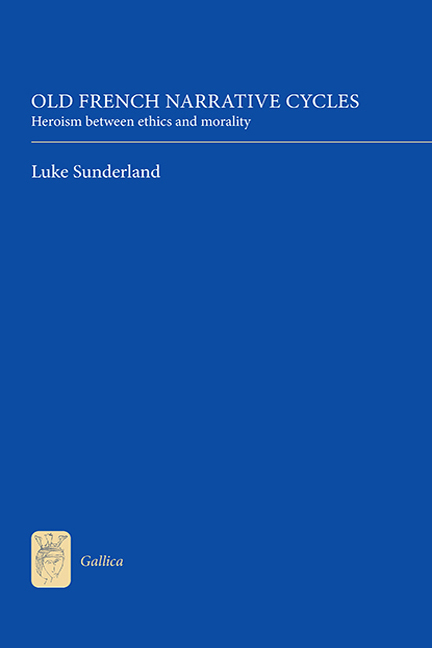Book contents
- Frontmatter
- Contents
- Dedication
- Acknowledgments
- Manuscripts of the Cycle de Guillaume
- Manuscripts of the Roman de Renart
- References and Abbreviations
- Introduction
- 1 Duty to the Geste: The Cycle de Guillaume d'Orange
- 2 Metaphor, Metonymy and Morality: The Vulgate Cycle
- 3 Responsibility to Reputation: The Prose Tristan
- 4 Ethical Evil: The Roman de Renart
- Conclusion
- Bibliography
- Index
- Miscellaneous EndMatter
1 - Duty to the Geste: The Cycle de Guillaume d'Orange
Published online by Cambridge University Press: 09 May 2017
- Frontmatter
- Contents
- Dedication
- Acknowledgments
- Manuscripts of the Cycle de Guillaume
- Manuscripts of the Roman de Renart
- References and Abbreviations
- Introduction
- 1 Duty to the Geste: The Cycle de Guillaume d'Orange
- 2 Metaphor, Metonymy and Morality: The Vulgate Cycle
- 3 Responsibility to Reputation: The Prose Tristan
- 4 Ethical Evil: The Roman de Renart
- Conclusion
- Bibliography
- Index
- Miscellaneous EndMatter
Summary
The Cycle de Guillaume d'Orange is a brilliant, complex, shape-shifting entity. It has a number of different incarnations, each made up of a large number of texts, composed over a long period by a series of different authors; these texts were compiled and reworked by scribes to produce magnificent cyclical manuscripts. The longest of these – known as B1 – features no fewer than eighteen chansons de geste. The most perfectly realized one, however, is B2. The table above (pp. ix–x) gives the list of dates for the songs found in B2, showing two key phenomena: the broad sweep of time involved in the elaboration of the cycle, and the difference between the order of appearance of texts in the codex and the order of their composition. In all manuscripts, the heroic biography of Guillaume – a knight best known for his daring capture of the Saracen city of Orange – is one integrating strand. But in all, other characters supplant him as hero: he is not always the focus of attention, nor the most ‘heroic’ character; his feats are not always the most impressive. Rather his nephew Vivien, a converted Saracen called Rainouart, his father Aymeri and other members of his lineage upstage him at times. One cycle, then, but many texts and several heroes. Running through the cycle in all its forms is a tension about who the hero is, which leads to a question about what a hero is.
One answer comes from the concept of the geste, a term which has anthropological, moral and textual elements, combing the meanings of lineage, heroic deeds and literary tradition. Thus the geste de Guillaume would refer to Guillaume's life and feats, those of his kinsmen and the chansons that tell of them. As set out in the famous prologue to Girart de Vienne, each geste has a traditional way of behaving. There are three gestes: the first is la geste du roi, that of Charlemagne and the kings of France, and this is ‘la plus seignorie’ [the noblest] (GV, 13). The second is la geste de Doon de Maience, a lineage of rebels and traitors, who are ‘plain d'orgueil et d'envie’ [full of pride and jealousy] (GV, 20). The third is la geste de Garin de Monglane (Guillaume's great-grandfather).
- Type
- Chapter
- Information
- Old French Narrative CyclesHeroism between Ethics and Morality, pp. 23 - 62Publisher: Boydell & BrewerPrint publication year: 2010

